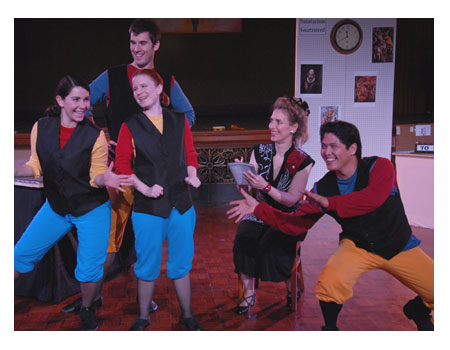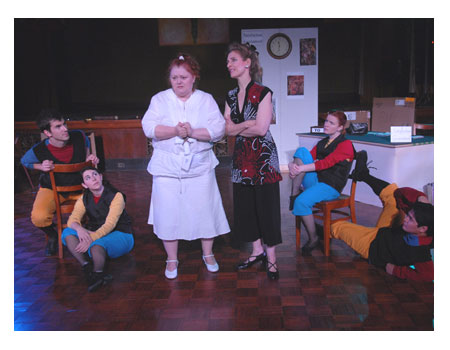


![]()
book, music & lyrics by Paula
Alprin
musical direction and arrangements by James
D. Watson
choreography by Tosia Anne Shall
directed by Brian Alprin
![]()
in the indoor amphitheatre of the George Washington Masonic National Memorial
"An enjoyable evening … a
little different, a little bit edgy … really good dance numbers,
and really good singing … you will like the music. The dialogue
scenes between Tina and Margery were very good. They were deep. Paula
Alprin did a very good job. She was very emotional and put a lot of heart
and soul into it. This was a really good show."
— ShowBizRadio
"A supernatural fantasy …
the musical segments offer some of the greatest pleasures of the piece,
including both the choreography and the quintet's spirited performance
of unusual arrangements of [Paula] Alprin's melodies … a wide range
of songs from the up-tempo To Beer or Not To Beer to the rock-ish
Add Up Sheep 'Cause Sleep's What Counts and from an Irish jig
of Whirling Girls to a faux Yiddish Theatre style Pass Over
Satyrs … they cast their spell early in the piece. [James D.]
Watson's arrangements vary from classical chamber music sounds …
to contemporary jazz guitar riffs … [Tosia Anne] Shall created an
acrobatic set of moves for the four singing dancers that is quite distinctive."
— Potomac Stages
"Top Pick!"
— Alexandria Times
CAST
Margery: DEBORAH RINN CRITZER
Tina: PAULA ALPRIN
and, as "The Course": LAURIE GEIGEL, GENEVIEVE JAMES,
SPENCER MICKELSON and ANDREW VERGARA RETIZOS
ORCHESTRA
Violin: MARCIA MCINTYRE
Cello: KATIE CHAMBERS
Guitar: ROB WEAVER
Bass: MARC DION
Keyboard: JAMES D. WATSON
DESIGNERS AND OTHER ARTISTS
Set Designer: TODD F. EDWARDS
Lighting Designer: JASON COWPERTHWAITE
Costume Designer: CAT MARTIN
Properties Designer: THEONI PANAGOPOULOS
Chief Scenic Artist: JODI LIEBURN
Gallery Artist: MELISSA TENNEY



DIRECTOR'S NOTE
Holiday time can bring unexpected presents. Paula received one in 1999
from her father. It was a sort of day-book, organized around a theme of
notable writers — one writer profiled each week, most of them well
known. Flipping through the pages, in the company of Euripides and Perrault,
MacLeish and Kosinski, Orwell and Phillis Wheatley, Paula first came across
Margery Kempe.
Years later, when Paula showed me a new work of hers, inspired in part by Margery Kempe and eventually titled Will You Know It’s Me? I had to confess to her that I had never heard of Margery Kempe either. The lives of medieval Christian mystics had never been a preoccupation of either of us. But Margery Kempe jumps from the pages of her own autobiography with so much force and color that she calls out for dramatization through a stageplay, historical novel, movie — or, in this case, a musical.
Margery Kempe is many different things to different people. For several centuries her magnum opus, known as The Book of Margery Kempe, was lost, and she was known only through the writings of a few others, and based on them people thought that she was an anchoress, although that is almost certainly not the case. When the complete manuscript of her Book was re-discovered in 1934, people began to credit her with being the first autobiographer in the English language. More recently some scholars, notably Lynn Staley, have suggested that while nominally an autobiographer she was a writer of no small amount of fiction and perhaps was a religious dissenter as well. But to those who know of her today, Margery Kempe is primarily considered to be an exemplar of fifteenth-century Christian piety and one of a small number of charismatic medieval Church figures who possessed the “gift of holy tears.”
Margery Kempe was born around 1373, the daughter of a prominent civic figure in the East Anglian town of Bishop’s Lynn (now called King’s Lynn). Married and the mother of fourteen children, Margery suffered through what a modern observer might conclude was a bout of post-partum psychosis and also developed an antipathy towards physical intimacy with her husband and a preoccupation with the Christian holy life. This led her onto several excursions through parts of England and abroad — she visited Canterbury and York and other domestic religious centers as well as more exotic pilgrimage destinations like Rome, Jerusalem, Assisi and Aachen. Like some other mystics, she developed a personal, conversational relationship with Jesus Christ which led her to receive detailed instructions as to how to live her life — what to wear, what not to eat and drink — which she evidently followed scrupulously. The holy visitations she received and the eccentric tendencies she displayed in public places led her to be examined for heresy, but she understood and was committed sufficiently to orthodox Christian beliefs that she was never found to be a heretic. Eventually Margery Kempe accumulated both prominent supporters and enemies within the Church hierarchy, and between her high public profile and her frequent travels, she lived an unusually dangerous life and was probably fortunate to have lived well into her sixties.
It appears that Margery was a charismatic personality who could attract a crowd. She was not a preacher, as that was an unorthodox concept within the medieval Church, but she did carry on in public. Glimpses of sights, scenes, or people could carry her through a process of free association into a religious experience that included prolonged weeping and wailing and, often, throwing herself on the ground and rapturously enduring apparent seizures. Margery maintained that her tears were a gift from God. Various clerics who were acquainted with her concurred that Margery was only able to cry when God willed it and that she was unable to withstand the onset of tears when God sent them. Her public demonstrations fed her notoriety. People either loved or hated her; but preoccupied with her visions, her hyper-emotional episodes and her religious vocation, Margery didn’t seem to care. Armed with her tears and her bliss, she sashayed through the Christian world of the time, an unforgettable personality.
The Margery of Will You Know It’s Me? is partially inspired by this strange historical figure, but ultimately refracted through the modern sensibilities of the work’s other protagonist, Tina. The dialogue of Tina and Margery spans virtually the entire length of Will You Know It’s Me? It sheds light on the essentially modern aspects of Margery Kempe, as her dramatized embodiment — the play’s “Margery” — careens recklessly between the Late Middle Ages and Tina’s world of today.
Throughout this dialogue the four colorful and timeless characters collectively named “The Course” sing, dance and weave a story that comments fancifully on Tina’s preoccupations. At the outset of Will You Know It’s Me? The Course represent and enact Tina’s escapade as an amateur storyteller. Over the course of the evening, however, The Course grow increasingly independent of Tina’s conscious imagination and even develop a kind of alliance with Margery. The puzzle that results from The Course’s detachment from and the play’s rearrangement of the original “rules of the game,” according to which The Course were a conscious expression of Tina’s art and Margery a peculiar interloper in Tina’s shop, is ultimately resolved in what I find a most satisfying conclusion.
— BRIAN ALPRIN
![]()
web design by Stillwell
Design © 2004 Natural Theatricals LLC
Photography by Stan Barouh
